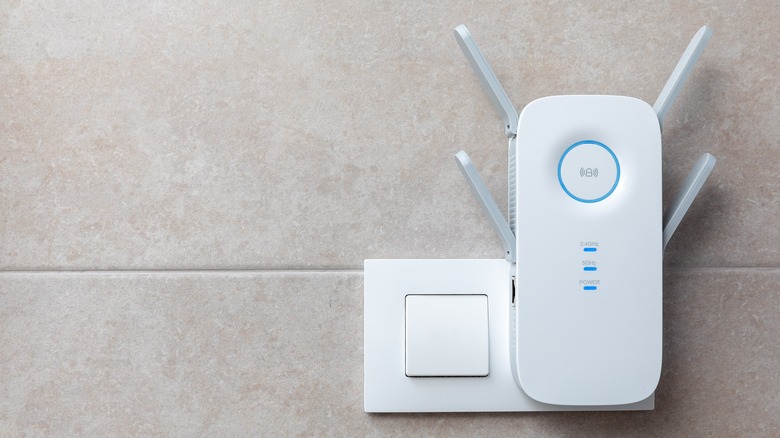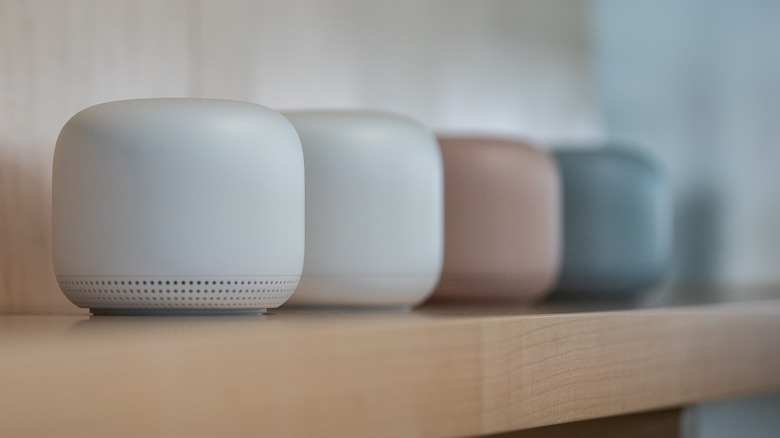What's The Difference Between A Wi-Fi Range Extender And A Mesh Network?
Do you have problems with your Wi-Fi at home? Maybe you can't quite get a signal in the backyard, and you'd like to relocate your home office to your patio deck during nice weather. Perhaps you live in a brick or cement building, and your Wi-Fi signal has a hard time penetrating through walls or floors. Different materials will react differently to Wi-Fi signals, as The Verge calculated, or maybe your cable company installed your access point in one corner of your house and the signal doesn't quite reach the other. Perhaps you just have a large house, and your router is simply not strong enough to hit the second floor.
What you need is a way to boost your existing Wi-Fi signal. There are two basic ways to do that: a Wi-Fi range extender, or a mesh network. Both have advantages and disadvantages. Mesh networks are generally considered the wave of the future, but a range extender may still get the job done without breaking the bank.
Is the problem with your network or your router placement?
Before you start shopping for gadgets, it's worth checking to make sure the problem isn't just with your router placement. Try putting your router in an optimal position for transmitting the signal. You may be limited on where you can locate it, depending on how your internet is connected, but in general you want your router to be in a high, central location away from other electronics like TVs, microwaves, and game systems. Try moving your router to a few locations, if you can, to see if that solves your problem. Also, make sure that your router has the antenna extended, if it's fitted with one.
If that doesn't work, check to see if your home internet is being throttled. Many ISPs (internet service providers) set data caps for monthly usage, after which the speeds you see may be intentionally reduced. The speed of your connection may also be significantly degraded if, say, most of your neighborhood uses the same ISP and everyone is trying to stream content at the same time. According to Lifewire, sometimes changing your router's network channel can help avoid interference from neighbors using Wi-Fi on the same frequency. If that doesn't solve your problem, a range extender or mesh network may be your answer.
Wi-Fi range extenders explained
A Wi-Fi range extender is a device that you usually plug into an outlet halfway between your router and the edge of your range. According to Tom's Guide, the biggest key to range extenders is placement. Follow the same guidelines you would for a router, using a high, central location with the antennas up. Next to the sliding door to your patio, for example, but not next to your microwave.
An extender repeats your Wi-Fi signal so to boost its range. A slight variation to this is a powerline extender, which uses your electrical wiring as a network cable, and can work well if your home is wired up appropriate. Even though Wi-Fi range extenders are just repeating the same signal as your regular Wi-Fi router, they act as a separate network. This means that you can't seamlessly travel from one location to another.
You can give both your router and the extender the same name and password, which may make it easier to work without managing multiple passwords and networks, but this may cause problems if your computer ends up sticking with the slower network rather than automatically choosing the one with the stronger signal. Giving each network separate names, in contrast, means you can label them by location: a reminder, for example, that your range extender's network should only be used when you're out on the patio. Wi-Fi range extenders are typically less expensive than mesh network access points. You also only need to buy one additional device, while you will usually need to replace your router with a mesh network in addition to any access points you buy to extend the system. Check to make sure the extender you choose is compatible with your router. You may, for example, need a system compatible with dual-band (2.4 GHz/5 GHz) networks or Wi-Fi 6E.
Mesh networks are gaining in popularity
A mesh network solves the problem of logging in and out of separate Wi-Fi extender networks, by making each device act as part of the same network. Whether you're on your patio or in your home office on the second story, your phone, laptop, or tablet will be connected to the same SSID. The signal can bounce efficiently between mesh access points, and each connection shares the work through a process called dynamic load balancing. This means that you have some built-in redundancy in your network in case one fails, and it means you can just keep adding access points in the future if necessary.
It's not just about convenience, either. Mesh networks typically don't have as much lag as you may see with a Wi-Fi extender, which is just repeating a signal from a single router. They're are also better able to handle homes that have a large number of connected devices, by prioritizing access: ensuring your online gaming or work video call get priority service to avoid lag or other slowdowns. Popular mesh network systems include the Linksys Velop, as well as the Amazon-owned Eero system and the Google-owned Nest Wi-Fi system.
In order to install a mesh network, you may have to replace your router as well as add any access points with devices from the same brand and system. If you have a modem and router combination (such as one supplied by your internet service provider), you may need to bypass the router function in order to use your new mesh network, or you may be able to use both in combination with the correct radio frequency. Check with your ISP for compatibility. Your new mesh router usually plugs directly into your internet modem through a supplied ethernet cable.
Typically, mesh networks are more expensive to set up than adding a Wi-Fi range extender. However, since all the mesh network devices are from the same company, it's usually easier to set up and maintain your system, as well as install any security updates that are released. As with Wi-Fi range extenders, you should make sure the system you choose is compatible with your devices and supports the same Wi-Fi bands in order to enjoy the maximum speeds.



